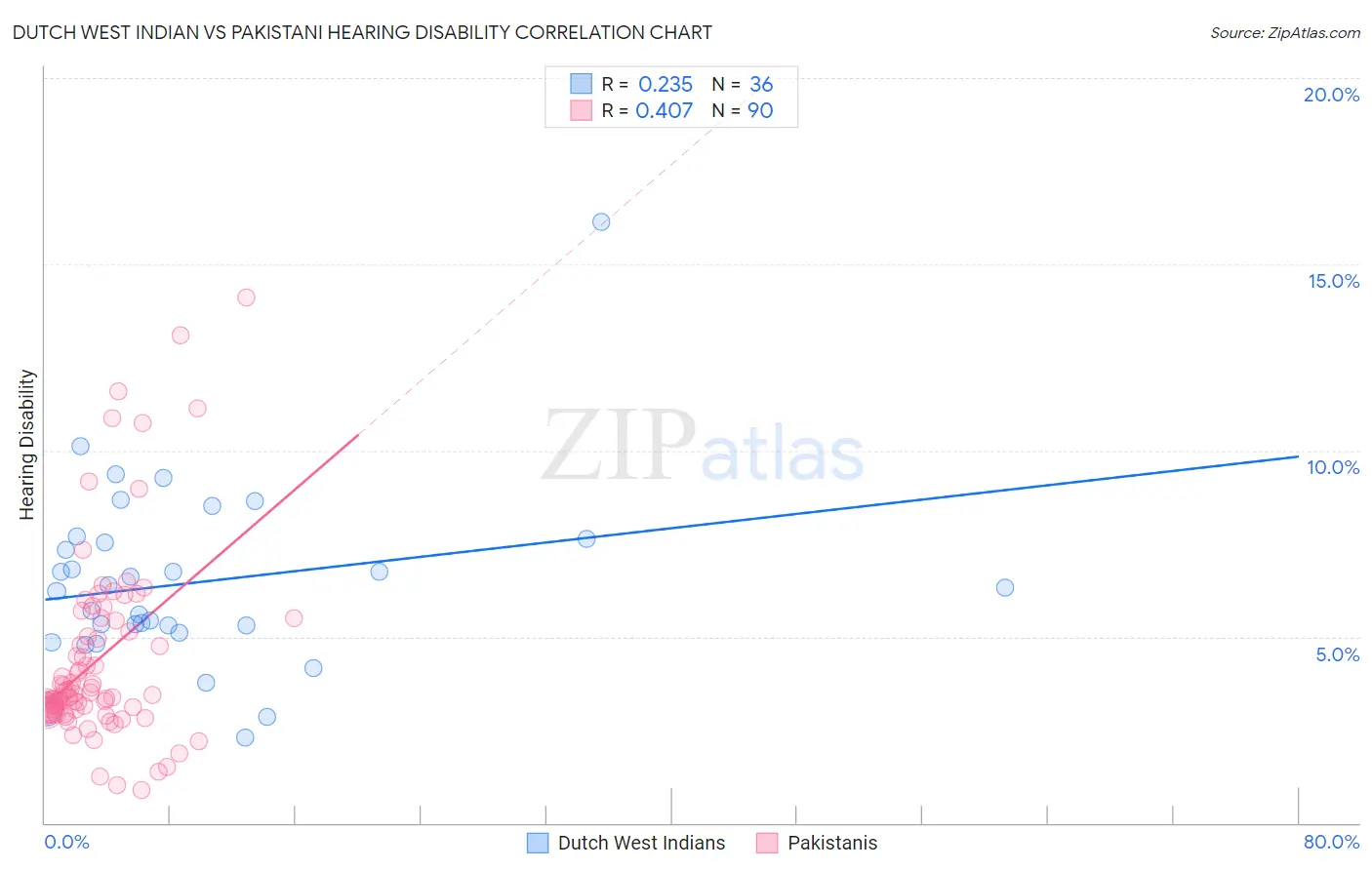Dutch West Indian vs Pakistani Hearing Disability
COMPARE
Dutch West Indian
Pakistani
Hearing Disability
Hearing Disability Comparison
Dutch West Indians
Pakistanis
4.3%
HEARING DISABILITY
0.0/ 100
METRIC RATING
333rd/ 347
METRIC RANK
3.1%
HEARING DISABILITY
11.1/ 100
METRIC RATING
212th/ 347
METRIC RANK
Dutch West Indian vs Pakistani Hearing Disability Correlation Chart
The statistical analysis conducted on geographies consisting of 85,766,796 people shows a weak positive correlation between the proportion of Dutch West Indians and percentage of population with hearing disability in the United States with a correlation coefficient (R) of 0.235 and weighted average of 4.3%. Similarly, the statistical analysis conducted on geographies consisting of 335,217,185 people shows a moderate positive correlation between the proportion of Pakistanis and percentage of population with hearing disability in the United States with a correlation coefficient (R) of 0.407 and weighted average of 3.1%, a difference of 35.5%.

Hearing Disability Correlation Summary
| Measurement | Dutch West Indian | Pakistani |
| Minimum | 2.3% | 0.88% |
| Maximum | 16.1% | 14.1% |
| Range | 13.9% | 13.2% |
| Mean | 6.5% | 4.4% |
| Median | 6.3% | 3.5% |
| Interquartile 25% (IQ1) | 5.2% | 3.0% |
| Interquartile 75% (IQ3) | 7.6% | 5.4% |
| Interquartile Range (IQR) | 2.4% | 2.4% |
| Standard Deviation (Sample) | 2.5% | 2.6% |
| Standard Deviation (Population) | 2.4% | 2.5% |
Similar Demographics by Hearing Disability
Demographics Similar to Dutch West Indians by Hearing Disability
In terms of hearing disability, the demographic groups most similar to Dutch West Indians are Aleut (4.3%, a difference of 0.54%), Houma (4.2%, a difference of 0.59%), Cherokee (4.2%, a difference of 1.3%), Native/Alaskan (4.2%, a difference of 1.4%), and Kiowa (4.3%, a difference of 1.9%).
| Demographics | Rating | Rank | Hearing Disability |
| Potawatomi | 0.0 /100 | #326 | Tragic 4.1% |
| Arapaho | 0.0 /100 | #327 | Tragic 4.1% |
| Tohono O'odham | 0.0 /100 | #328 | Tragic 4.2% |
| Crow | 0.0 /100 | #329 | Tragic 4.2% |
| Natives/Alaskans | 0.0 /100 | #330 | Tragic 4.2% |
| Cherokee | 0.0 /100 | #331 | Tragic 4.2% |
| Houma | 0.0 /100 | #332 | Tragic 4.2% |
| Dutch West Indians | 0.0 /100 | #333 | Tragic 4.3% |
| Aleuts | 0.0 /100 | #334 | Tragic 4.3% |
| Kiowa | 0.0 /100 | #335 | Tragic 4.3% |
| Creek | 0.0 /100 | #336 | Tragic 4.4% |
| Chickasaw | 0.0 /100 | #337 | Tragic 4.5% |
| Alaska Natives | 0.0 /100 | #338 | Tragic 4.5% |
| Choctaw | 0.0 /100 | #339 | Tragic 4.5% |
| Pueblo | 0.0 /100 | #340 | Tragic 4.6% |
Demographics Similar to Pakistanis by Hearing Disability
In terms of hearing disability, the demographic groups most similar to Pakistanis are Immigrants from Iraq (3.1%, a difference of 0.15%), Romanian (3.1%, a difference of 0.21%), Cape Verdean (3.1%, a difference of 0.25%), Immigrants from Hungary (3.1%, a difference of 0.29%), and Immigrants from Latvia (3.1%, a difference of 0.33%).
| Demographics | Rating | Rank | Hearing Disability |
| Alsatians | 15.9 /100 | #205 | Poor 3.1% |
| Eastern Europeans | 15.5 /100 | #206 | Poor 3.1% |
| Hispanics or Latinos | 15.1 /100 | #207 | Poor 3.1% |
| Immigrants | Latvia | 12.7 /100 | #208 | Poor 3.1% |
| Immigrants | Hungary | 12.5 /100 | #209 | Poor 3.1% |
| Cape Verdeans | 12.2 /100 | #210 | Poor 3.1% |
| Romanians | 12.1 /100 | #211 | Poor 3.1% |
| Pakistanis | 11.1 /100 | #212 | Poor 3.1% |
| Immigrants | Iraq | 10.5 /100 | #213 | Poor 3.1% |
| Australians | 8.1 /100 | #214 | Tragic 3.2% |
| Bangladeshis | 8.1 /100 | #215 | Tragic 3.2% |
| Immigrants | Norway | 7.3 /100 | #216 | Tragic 3.2% |
| Russians | 7.1 /100 | #217 | Tragic 3.2% |
| Immigrants | Northern Europe | 7.0 /100 | #218 | Tragic 3.2% |
| New Zealanders | 6.8 /100 | #219 | Tragic 3.2% |